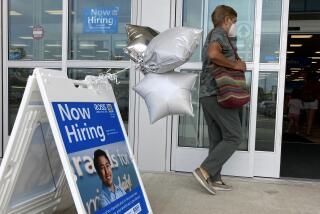Productivity Growth Slows in 4th Quarter
- Share via
The pace of U.S. worker productivity growth slowed at the end of 2004, and new claims for jobless aid slipped last week, according to reports raising both job growth hopes and inflation concerns.
Separate reports released Thursday also showed that growth in the huge U.S. service sector cooled a bit last month and that factory orders rose a mere 0.3% in December.
Nonfarm business productivity, or worker output per hour, grew at an annual rate of 0.8% in the fourth quarter, falling from the third quarter’s 1.8% rate. It was the smallest advance since a drop in the first quarter of 2001, the Labor Department said.
The slowdown caused unit labor costs, a key gauge of inflation or profit pressures, to rise at a 2.3% rate, the biggest jump in 2 1/2 years and a step up from the third quarter’s 1.6% pace.
In a separate report, the department said initial claims for state unemployment benefits fell to 316,000 last week from 325,000 a week earlier, matching a figure reached seven weeks ago as the second lowest since before the economy tipped into recession in 2001.
Financial markets today will look closely at January employment data from the Labor Department for further clues on the labor market. Economists expect a healthy 190,000 gain in nonfarm jobs.
“Companies can’t squeeze more out of their existing workforce. They must hire,” said Christopher Low, chief economist at FTN Financial in New York.
For all of 2004, productivity grew a robust 4.1% -- capping an extraordinary three-year period in which it shot up faster than at any other comparable period in nearly 50 years of record keeping.
Still, last year’s advance marked a bit of a slowdown from 2003 and reflected year-over-year changes that moved progressively lower throughout 2004.
Fast productivity growth allows businesses to pad profits or boost pay without raising prices. As productivity slows, companies are forced to hire more workers and face smaller profits unless they can push up prices.
Economists said the report on jobless claims suggested the pace of job growth could well quicken.
A four-week moving average of initial claims, which smooths weekly volatility to provide a better sense of underlying trends, fell by 10,250 to 331,500, the lowest level since the start of the year and the second-lowest since November 2000.
In another upbeat sign for the labor market, the number of unemployed still on the benefit rolls after an initial week of aid dropped by 116,000 to 2.7 million in the week ended Jan. 22. The drop brought the four-week average for continued claims to its lowest since April 2001.
In a third report, the Institute for Supply Management said its non-manufacturing index, which measures activity in the service sector, slid to 59.2 from a revised 63.9 in December.
The index indicated that growth in the sector, which accounts for about 80% of the U.S. economy, remained solid, although the number fell short of the 61.3 expected on Wall Street.
More to Read
Inside the business of entertainment
The Wide Shot brings you news, analysis and insights on everything from streaming wars to production — and what it all means for the future.
You may occasionally receive promotional content from the Los Angeles Times.






